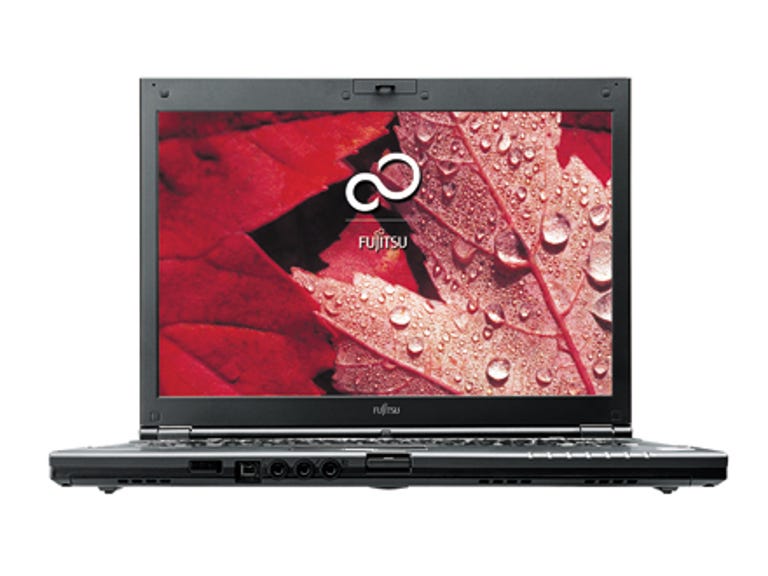 Why You Can Trust CNET
Why You Can Trust CNET Fujitsu LifeBook S6410 review: Fujitsu LifeBook S6410
The Fujitsu LifeBook S6410 boasts a brilliant screen, good performance, and useful features -- but we've seen better from the company.
updated Smaller and faster -- that's usually been the motto of computer manufacturers. And none have adhered to this creed better than Fujitsu. Their last few ultraportable notebooks have been both excellently designed and powerfully economical. The Fujitsu LifeBook S6410 is the company's latest, and is compliant with the latest Intel Centrino standard. It sports several competitive features including an LED backlit screen, 1GB of Turbo Memory, and a removable drive bay.
The Good
The Bad
The Bottom Line
Design
This notebook features the use of magnesium alloy and carbon fibre for a combination of strength and light weighted-ness. It's not as thin as some ultraportables we've seen, but despite its relative chubbiness it still only weighs 1.66 kg.
The LCD is a 13.3-inch model and the LED backlighting makes this one of the brightest we've seen. In fact, as far as clarity and viewing angles are concerned it even outstrips Fujitsu's own Q2010, which is almost AU$1,500 more. The only problem with LED backlighting is that you lose a lot of contrast -- black comes out grey -- and it's not the best choice for multimedia applications.
Build quality was pretty solid -- the first model we saw was pre-production and a little flimsy around the screen, but the production model seems to have remedied this.
The one misgiving we had about the Fujitsu is in the design of the battery chamber. Rather than simply push in like most batteries do, the Fujitsu's battery sort of locks in place via a complex twist from the front to back -- you can't slide it in. The battery contacts on the pre-production model had been shredded by the time we received it, and despite assurances from Fujitsu, the battery design remains the same on the final model. But put the battery in correctly and there shouldn't be an issue.
Features
Centrino Duo notebooks have been filtering into the market since mid-June, but the S6410 is still one of the first laptops we have seen to include Santa Rosa features. Ticking off the list you get: an Intel Core 2 Duo T7500 processor at 2.2GHz; a relatively skimpy 1GB of RAM (this is Vista after all -- we would have liked 2GB); a roomy 120GB of hard drive space; Turbo Memory; and a draft-N wireless adaptor.
Being a Santa Rosa, it also features an Intel X3100 graphics adaptor, and it really takes the load off the other components while running Vista Business in Aero mode. Despite only having 1GB of RAM, there were no slowdowns or "chugging" while using the PC with all the eye-candy enabled. You wouldn't want to use this PC for games though.
For ports, you get a front-mounted mic and headphone jack, a 1394 mini-jack, an S-Video out (via a dongle) and a wireless on/off switch. On the left-hand side you get a LAN port, VGA, PCMCIA (Fujitsu doesn't believe there's enough saturation for ExpressCard accessories to warrant its inclusion yet), and a card reader. On the right side you get three USB 2.0 ports, a modem and the removable drive bay. You can choose to install a weight saver or another hard drive in there if you wish -- there is also a second six-cell battery available for this slot at an extra AU$299.
Performance
The Fujitsu is factory fitted with a six-cell battery, and it performed adequately in our battery test. Using the BatteryEater Pro 2.70 benchmark, we were able to clock the S6410 at a speed of 2 hours and 40 minutes. A little short when compared with a competitor such as the Acer TravelMate 6292 which was able to last an extra 40 minutes -- and this is without Turbo Memory. The inclusion of Turbo Memory should help the Fujitsu here, because this is really a test of how long the laptop can last with the monitor on at full brightness. It's not demanding on the CPU or memory, and should be caching from the Turbo Memory module. In this instance, it doesn't appear to have made as much difference as Intel has suggested. The Acer is without the Turbo Memory upgrade.
On the performance side, it's on a par with the Acer at 4156 marks in the PCMark 05 benchmark. This demonstrates that the two notebooks are very evenly matched, with the Acer achieving 4192 marks. PC Mark, while a synthetic test, is a good measure of how the laptop performs across disciplines such as start-up time, graphics performance, and CPU calculations.
In the end, the Fujitsu is a good laptop, with a brilliant screen, some useful battery-saving features and a decent appearance. Only its unusual battery chamber design holds us back from whole-heartedly recommending it.


